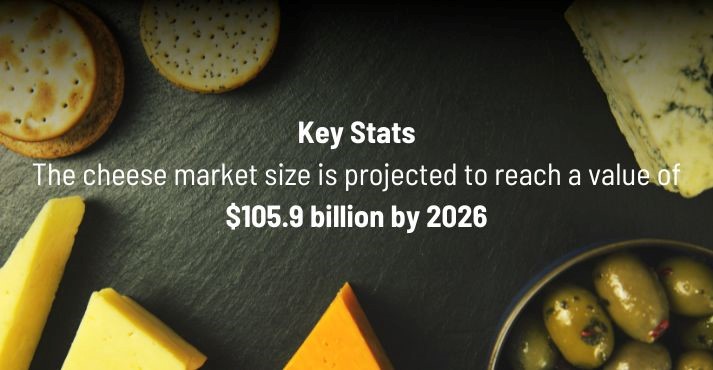Cheese, the beloved dairy product, has been a staple in the food and beverage industry for centuries.
Customers’ evolving interests and preferences are driving the trends in the cheese market. The global cheese market is transforming due to a growing appetite for new flavors and varieties.
The revenue in the global cheese market amounts to US$30.4 billion in 2023 and is expected to grow further. The trends shaping the cheese market are driven by an increased awareness of good sources of nutrients, such as calcium, phosphorus, zinc, vitamin A, and vitamin B12, which are vital for bones and provide essential proteins for strong muscles.
Let’s explore the factors contributing to this remarkable growth and the exciting opportunities ahead.
Cheese Market Global Key Insights

According to a report by MarketsandMarkets, the cheese market size is projected to reach a value of $105.9 billion by 2026, and the cheese market is expected to grow at a CAGR of 3.6%. The rising adoption of cheese products in different cuisines drives growth in the cheese market.
Global cheese consumption has significantly increased over the past few years, particularly since 2015. Almost half of all cheese production in the world is produced by the European Union.
The key drivers of the global cheese market are:
- Increased demand for protein-rich food products
- Changing consumer preferences half of all cheese production
- Growth of the food service industry
- Expansion of distribution channels
The major players operating in the cheese market are Arla Foods, Bel Group, Fonterra Food, Kraft Heinz, Lactalis Group, and Britannia Industries Limited.
While the other players in the value chain include Almarai Co. Ltd., Sargento Foods Incorporated, FrieslandCampina, Dzintars, Go Cheese, Parag Milk Foods, and Gebrder Woerle.
Here’s a list of top-quality cheeses made from goat and sheep milk:
- Feta
- Roquefort
- Pecorino Romano
- Manchego
- Chèvre
- Cabrales
- Valdeón
- Halloumi
- Bucheron
- Garrotxa
- Zamorano
- Serra da Estrela
- Crottin de Chavignol
- Ragusano
- Sardinian Pecorino
- Pyrenees Brebis
- Pouligny-Saint-Pierre
- Malvarosa
- Selles-sur-Cher
- Ossau-Iraty
As cheese has been an essential part of our daily lives, manufacturers see the benefits of exploring new products and technology to ensure no compromise on the overall quality of the end product.
Government regulations in different countries are significantly impacting the dairy industry trends. For example, strict food safety and labeling regulations in the United States can increase production costs for cheese manufacturers, potentially limiting market expansion.
In contrast, European countries’ protected designation of origin (PDO) regulations can promote traditional cheese varieties, fostering growth in artisanal segments. Additionally, tariffs and trade policies can influence international cheese trade, affecting market dynamics.
Impact of COVID-19 on the Cheese Market
COVID-19 changed the world scenario with its significant impacts on the economy and businesses across the globe. The prolonged impact of the pandemic disrupted the cheese market by changing the demand and supply dynamic, causing interruptions in the supply chain and declining demand due to lockdowns.
The global cheese players witnessed raw material shortages, movement restrictions, and economic challenges that led to market decline. The closure of the hotel, restaurant, and catering industry mainly resulted in a substantial decline in cheese sales.
Export-reliant countries experienced reduced demand as global trade slowed down. Import-dependent countries faced supply chain disruptions, affecting their cheese availability.
Also, the manufacturer was promoted to seek alternative distribution channels and adapt their product offerings. Yet, the demand for comfort and convenience food like cheese-based snacks grew, driven by the changing lifestyle, consumption patterns, and preferences.
Cheese Market Segmentation

Loved for its richness, creaminess, flavor, and satiating qualities, cheese comes from different sources, consists of different types, and has various forms.
Cheese Source
Cheese can be sourced from animals or plant-based sources. Segmentation based on cheese sources can be categorized into:
- Animals: Cow, goat, or sheep
- Plant-based: Soy, almonds, or cashews
Cheese Type
As different cheese varieties cater to different consumers, tastes, and preferences, they can be segmented based on the following cheese types:
- Hard cheeses
- Semi-hard cheeses
- Soft cheeses
- Blue-veined cheeses
- Fresh cheeses
- Processed cheeses
Form Analysis
Cheese comes in a variety of forms and can be categorized into the following:
- Soft (e.g., brie, cream cheese)
- Semi-soft (e.g., mozzarella, Swiss)
- Hard (e.g., cheddar, Parmesan)
- Others, like blue cheese or cottage cheese
Distribution Channels in the Cheese Market
From farm to fridge, the cheese products undergo various distribution channels before they reach you. The distribution channels for cheese encompass:
1. Supermarkets and Hypermarkets
Supermarkets and hypermarkets provide convenience and allow consumers to explore different cheese brands and types in one location.
2. Convenience Stores
They cater to consumers seeking quick and easily accessible options like cheese and cheese snacks.
3. Specialty Stores
They provide a curated selection of artisanal, gourmet, and unique cheese varieties, making them a go-to destination for cheese enthusiasts looking for high-quality and distinctive options.
4. Other Distribution Channels
This category includes online retail, farmers’ markets, and food service operation establishments. Food service establishments such as restaurants and hotels source cheese through specialized food distributors.
Exploring New Geographical Frontiers
While Europe has been long associated with cheese production and consumption, the demand for cheese is expected to skyrocket in growing markets such as Asia-Pacific, Latin America, and the Middle East. The new markets are gaining traction mainly due to increasing disposable incomes, changing dietary habits, and a growing influence of Western cuisine.
There are endless possibilities for domestic and international cheese producers to tap into these markets and establish a new frontier in that location.
Europe
Due to rich cultural tradition, the EU consumed about 9.4 million metric tons of cheese in 2022, far exceeding consumption in other parts of the world. Partnerships with local dairy farmers and artisanal cheese producers in the EU ensure a steady supply of high-quality ingredients.
Aisa Pacific
The cheese market volume is expected to amount to 5.2bn kg by 2028 for the Asia Pacific region, and a volume growth of 5.3% is expected by 2024. Key players in this region focus on diversifying their product portfolios to cater to local tastes.
South America
The revenue in the South American cheese market amounts to US$11.1 bn in 2023 and is expected to grow annually by 7.78% CAGR by 2028. Key players focus on partnerships with regional dairy producers and acquire local cheese brands to expand their presence and offer a broader range of options.
Middle East
The rising population, changing dietary habits, and increasing acceptance of cheese as part of Middle Eastern cuisine have increased consumption in the region. Key players in this market often emphasize diversifying their product portfolios and producing cheeses like labneh and halloumi and more familiar varieties like mozzarella and cheddar.
Africa
While cheese is not a traditional part of an African diet, almost 50 percent of the population consumes cheese in the region. Key players in the market focus on partnerships with local farmers and less on acquisitions due to the relatively smaller size of the cheese industry.
Competitive Landscape
The global cheese market is highly competitive, owing to the local and international players—several vital players influence the competitive landscape in the cheese market.
- GCMMF (Amul)
- Arla Foods amba
- Fonterra Co-operative Group Limited
- Almarai Company
- Land O’Lakes, Inc.
Government bodies play a crucial role in supporting the production and competition in the cheese industry by providing subsidies, research and development grants, or developing policies that promote domestic dairy production.
For instance, GCMMF (Amul) has benefitted from government initiatives to boost milk production and dairy farming in India. This kind of support encourages new entrants to the market and helps them make huge investments.
The cheese market generally has relatively low entry barriers due to the availability of raw materials. For example, key players like Fonterra and Land O’Lakes have leveraged this advantage to enter and expand in international markets, capitalizing on their dairy resources and expertise.
Moreover, diversification, innovation, and product acquisitions help key players stay competitive and increase their market share.
Future Key Developments
Manufacturers start to innovate as customers look for new options and flavors in the cheese market. The two most prominent future developments in the cheese industry include growing demand for specialty cheese and sustainability.
Specialty Cheese Production
Specialty cheese production tops the list of emerging cheese trends. Every cheese includes specialty cheeses, whether it is a more high-end version of everyday table cheese. Specialty cheese production focuses on crafting distinctive and artisanal cheeses that stand out from mass-produced varieties.
These cheeses often feature unique flavors, textures, and aging processes, making them a gourmet choice for consumers seeking something different. Examples include artisanal blue cheeses, rare washed-rind varieties, and specialty goat or sheep milk cheeses.
Sustainable Cheese Production
Sustainability is becoming the new norm, with no exception to the cheese industry. Cheese manufacturers and producers implement eco-friendly practices throughout production, from sourcing milk from local and organic farms to reducing carbon emissions during manufacturing.
For example, Clo-Clo, a Swiss cheese brand, prioritizes sustainable and transparent practices, from animal welfare to environmental impact.
Frequently Asked Questions (FAQs)
How much is the cheese market worth?
The global cheese market was valued at over 83.4 billion U.S. dollars in 2022 and is forecast to reach over 120.2 billion by 2028.
What is the growth rate of the cheese market?
As the demand for cheese consumption and production increases, the global cheese market is expected to grow annually by 7.25% (CAGR 2023-2028).
What are the key trends affecting the cheese market?
Key trends affecting the cheese market include:
- Plant-based cheese alternatives
- Sustainable production
- Premium and specialty cheese
- Global flavor fusion
- Regional and terroir-inspired cheeses
- Reduced lactose options
What is the primary market restraint?
Some of the significant cheese market restraints include:
- High fat and calories
- Lactose intolerance
- Supply chain disruptions
- Sustainability challenges
- Competition from plant-based dairy alternatives
- Cultural and dietary preferences
- Trade barriers and tariffs
- Impact of global economic recession
Who is the biggest consumer of the cheese market?
The biggest consumers of the cheese market include:
- United States
- EU
- Russia
- China
- Mexico
- Australia
- India
- Japan
- Canada
- South Korea
- Middle East
Conclusion
The trends in the cheese market are changing as consumers are looking for new taste experiences, health concerns, and competition remain high.
Therefore, adapting to the industry’s evolving dynamics and further unlocking possibilities can help cheese manufacturers leverage the opportunities in the market worldwide.
In a nutshell, the cheese market is gaining traction as consumer demand grows. It is time for cheese manufacturers to step forward and explore new geographical frontiers to expand their business with global flavor fusion.













